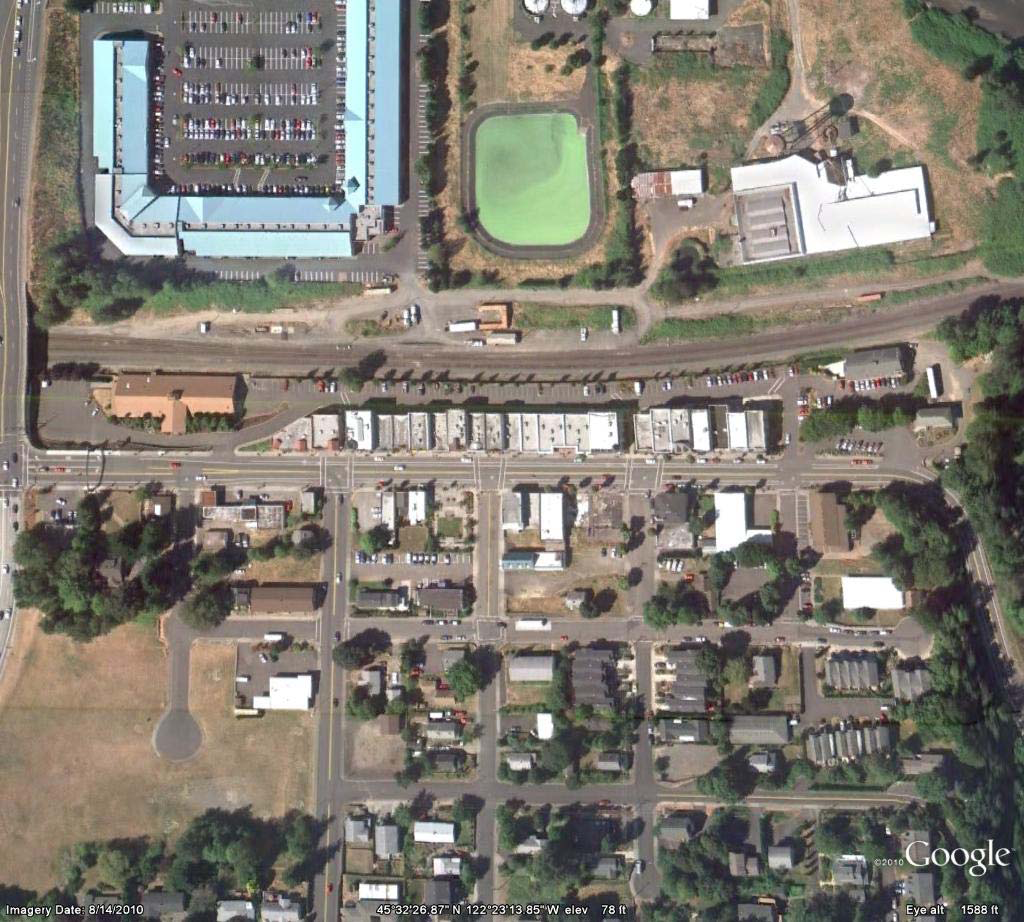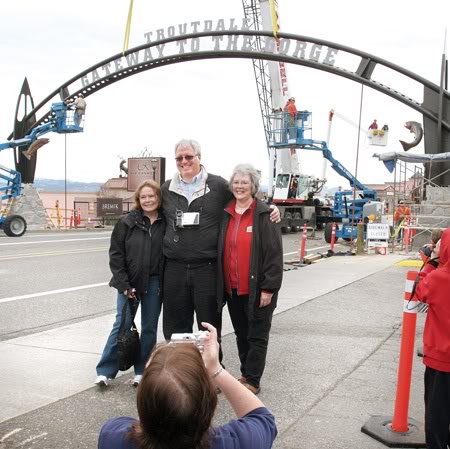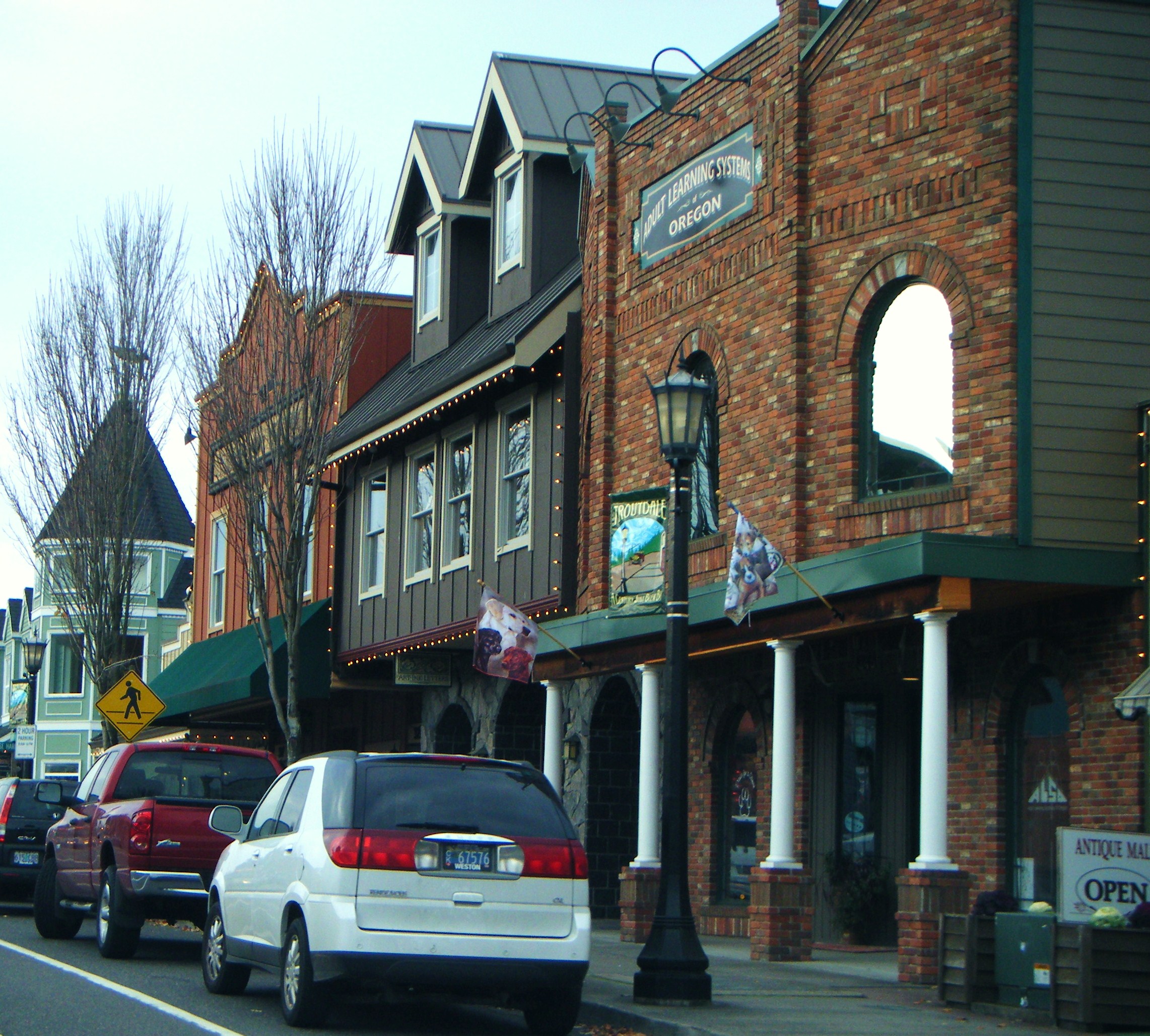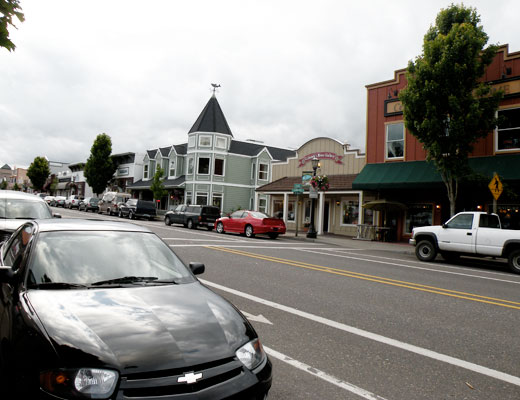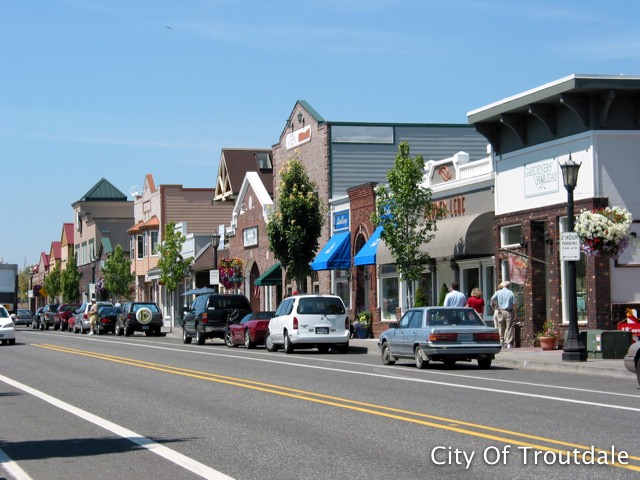Multnomah, Oregon
Background
The Historic Columbia River Highway runs through downtown Troutdale in Oregon. It is an approximately 0.3 mile long and 50-foot wide boulevard, which consists of a 12-foot wide travel lane, an on-street parking lane, and a striped bike lane in each direction. The sidewalk on the north side is 8 feet to 9 feet wide while the one on the south side is approximately 4 feet at the narrow points. Crosswalks are in place at most intersections along this section.
It is a very popular route for weekend cyclists heading to the Columbia River Scenic Gorge. Traffic volumes are not excessive outside of peak hours. The street cross section with parking, wide sidewalks and zero setback storefront affords an improved retail draw for the area (Valencia 2011).
Troutdale's historic, five-block main street was in serious decline by the late 1980s. But a series of changes reversed the trend in the 1990s. The City attracted the Columbia Gorge Factory Stores, immediately adjacent to the downtown area along Interstate-84. The mall brings thousands of shoppers to this eastern gateway to the Portland region, setting up a larger market for the main street.
The creation of the Columbia River Gorge National Scenic Area established Troutdale as the de-facto gateway to the Gorge from the Portland metropolitan area since the city abuts the scenic area’s western edge. The Oregon Department of Transportation (ODOT) bolstered the new scenic area designation with a major restoration of the Columbia River Highway to its former glory, attracting more visitors through downtown Troutdale en route to destinations in the Gorge like Crown Point and Multnomah Falls.
The project initially focused on the north side of the Columbia River Highway, a move that might have seemed ill-advised since most of the original storefronts were on the south side of the street. Yet, this strategy resulted in a ‘complete” main street, and is making the vacant parcels on the south frontage much more attractive as development continues.
A number of the new structures also include mini-plaza areas in their entry designs that expand the pedestrian area where it is needed most. The project also retains the historic street lamps that have decorated this section of the Columbia River Highway since it was constructed in the early 1900s. On-street parking was preserved on both sides of the street - a significant accomplishment in a state DOT-owned facility. The project also includes Mayor's Park, with a small plaza, seating and drinking fountains. Though modest, it serves as an important public gathering space in Troutdale.
Another piece to the puzzle was the acquisition of a former county poor farm, located just west of the downtown, by an eccentric brewpub chain operated by Mike and John McMenamin. Together the brothers converted the farm into McMenamin's Edgefield Estate, a sprawling campus with hotel, brewpub and winery that is now listed in the National Historic Register.
The City of Troutdale partnered with private developers to aggressively rebuild the missing half of storefronts along the north side of Columbia River Highway. In a unique public-private partnership, a row of nearly two dozen new storefronts has been constructed since 1995 on land originally owned by Union Pacific Railroad.
Adopted from: Green Streets
In 2010, the 68-foot steel Centennial Arch was built as a welcoming gate to the downtown area. It is designed to withstand winds up to 110 mph and 3 inches of ice. Built-in lighting illuminates the two metal support sculptures at night. While the project cost approximately $363,000, the city and community expect this inviting arch will bring more tourists and economic boom to the community (Wells 2010).
Lessons Learned
Potential Benefits:
- Preserves neighborhood identity.
- Provides cycle lanes and access.
- Increases green space by providing mini-plazas and parks.
- Provides access to Interstate 84 and Columbia River Gorge.
- Creates an interesting small downtown area with some unique shops.
Potential Issues:
- Narrow sidewalk: The new striped bikeways on both sides of the street came at the price of relatively narrow sidewalks. The innovative mini-plaza design on several newer buildings increases pedestrian space. However, the sidewalk still feels cramped.
- Lack of adequate pedestrian crossings: Markings at all intersections and curb extensions at some intersections would be major improvements, as well as a controlled intersection at Buxton Avenue, where vehicles routinely fail to yield to pedestrians when making turning movements.
- Wind issues: Cold wind blasts out of Columbia River Gorge most of the year.
- Visual access: Most people miss the downtown shops due to the huge Factory Outlet complex by Interstate 84.
Sources
Wells, Shannon, March 16, 2010. “Arch rises above downtown Troutdale” Portland Tribune (http://www.portlandtribune.com/news/print_story.php?story_id=126878903191947000)
Glabah “Oregon Gateway to Gorge and Local Shopping“ (http://members.virtualtourist.com/m/5f9c8/d0600/)
Green Streets (http://www.greatstreets.org/MainStreets/MainStTroutdale.html)
Interview with Joanna Valencia, Transportation Planner, Multnomah County Department of Community Services, Land Use & Transportation Program on July 1, 2011
Photo Sources
MIG, Inc.

